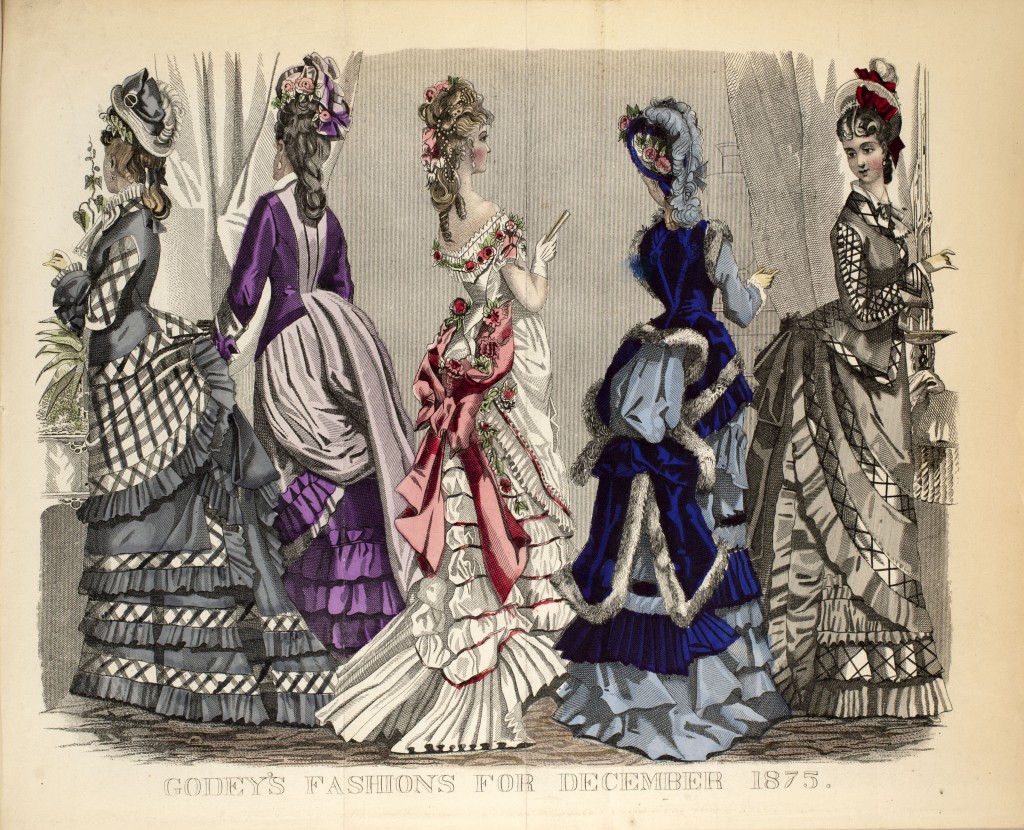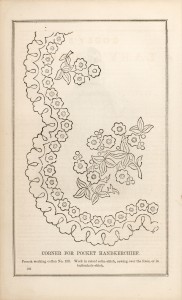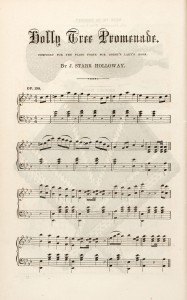Leaf through the pages of Glamour or Vogue in mid-March and the inventory will reveal that American fashion designers’ thoughts have turned to the spring line. Here at the American Antiquarian Society, when our thoughts turn to fashion, they turn to hoopskirts and side curls and to the famed fashion plates of Godey’s Lady’s Book. As March is women’s history month, we thought it the perfect time to examine this “Lady’s Book.”

As you might know, Godey’s Lady’s Book was the number one selling periodical in Victorian America. Mr. Godey himself calculated the number of readers at a million by the eve of the Civil War. You might also know that the colored fashion plates at the beginning of the magazine were its most famed component. But did you know that the colored plates were hand painted? That the ‘lady editor’ of the magazine was vehemently opposed to including fashion plates in a woman’s periodical? That the magazine played an integral role in establishing Thanksgiving as a national holiday? That hoopskirts were gigantic during the Civil War? All of this information and more can be found in original issues of Godey’s Lady’s Book in the collections at the American Antiquarian Society along with secondary source material on the creation of the magazine. Godey’s Lady’s Book contains not only a wealth of information about Victorian fashion but also about the culture of bygone America.
The ‘lady editor’ of Godey’s Lady’s Book was Sarah Josepha Hale, a literary-minded social reformer whose civic-minded zeal rivaled that of Lucretia Mott and Harriet Beecher Stowe. She edited the magazine along with its owner, Louis A. Godey, from 1837 to 1877. Many are familiar with Hale solely for her authorship of “Mary Had a Little Lamb,” but Sarah Hale’s accomplishments reached far beyond a poem for children. Formal education for women at the time was scant. Hale derived much of her education from a brother who attended Dartmouth College and tutored Sarah at home. After losing her husband at a young age, Hale went on to support her family through literary means, successfully submitting novels and shorter pieces to publishers. She edited the Boston-based Ladies’ Magazine, the first women’s magazine in America. In the magazine, she included original literary pieces by American authors, an unusual practice at a time when American magazines borrowed heavily from those of Europe. As editor, she promoted women’s education and worthy social causes. She spearheaded the completion of the Bunker Hill Monument and founded the Seaman’s Aid Society of Boston to give monetary relief to the families of poorly paid sailors.

In 1837, she partnered with Louis Godey as co-editor for Godey’s Lady’s Book, which was a second-rate magazine until Hale came aboard. As editor of Godey’s, Hale promoted women as heads of female boarding schools, advocated for the retention of married women’s property rights, and opposed the current fashion trend of tight bodices for women’s dresses on grounds that they were unhealthy. She championed Elizabeth Blackwell, was integral in establishing the observance of Thanksgiving as a national holiday, which she believed would help unite a country divided by slavery, and promoted the creation of Vassar College, the first women’s college in America. She staunchly opposed including fashion plates in a woman’s magazine on grounds that they were frivolous.
Louis A. Godey, a Philadelphia publisher and the owner of Godey’s Lady’s Book, was the other vivid character involved in the creation of the magazine. Hailing from two of the world’s fashion centers, as a New Yorker of French descent, Louis fervently believed in including fashion plates in his magazine, overriding Hale’s opposition to them. Sharing Hale’s journalistic vision and interest in the new womanhood being promoted in America at the time, he complemented Hale as a charming extrovert with a flair for business. He knew that a female co-editor would be well received by the American reading public of the time and reputedly flattered Sarah into accepting the position. He insisted that the magazine not take a political stance during the Civil War in order to avoid alienating Southern readers. He suavely referred to his readers as “dear readers” and “the fair ladies.” He promised a free copy of his magazine to subscribers who failed to receive a copy, a common phenomenon at a time when the mail service in America was unreliable. Most notably, he insisted on including the colored fashion plate with which every issue of Godey’s commenced, and which would become its most beloved feature. Godey was also the first person to copyright a periodical in America with his copyrighting of Lady’s Book.
The impressive joint effort of these two editors was Godey’s Lady’s Book. The magazine was in print from 1830 to 1878. Its circulation doubled that of rival magazines. It was published at 113 Chestnut Street in Philadelphia on a monthly basis and was read by both men and women. Each page of the magazine was printed on a hand held flat-bed press. The printed sheets were folded and sewn by hand. The colored plates were hand painted in Philadelphia both at the Godey plant and in the home of young women hired to assist with the painting. Artists sometimes misunderstood coloring instructions. When the supply of color ran out, they often switched to other colors. This resulted in different subscribers receiving differently colored fashion plates, and made women unsure about the latest style when comparing their copy of the magazine to their neighbors’! Godey boldly smoothed the situation over with characteristic charm, “We now colour our plates to different patterns, so that two persons in a place may compare their fashions, and adapt those colours that they suppose may be most suitable to their figures and complexions” (Finley 54).
 Early American fashion can be charted by following the changing clothing design in the colored plates of Godey’s Lady’s Book. Crinolines gave way to hoops, skirt width expanded with increasingly elaborate trim, sleeves tightened and loosened, hoops evolved into bustles. Dresses required at least twenty-five yards of material, and often weighed so much they were difficult to wear! As a result, not all women wore hoops and no one wore them all the time. Ringlets, flared sleeves, knitted hoods, bows on children’s dresses, checkered pants, gowns of “peach-blossom hue,” cashmere morning robes of Persian design, beaded opera hats, gentlemen’s mitts, and flower adorned bonnets are among the many fashions to be found in the magazine’s pages. Along with fashion plates, the magazine included recipes, embroidery patterns, sheet music for the piano, suggestions of hairstyles, lessons in drawing, suggestions for interior decorating, and original American literature, including pieces by Hawthorne, Holmes, and Irving.
Early American fashion can be charted by following the changing clothing design in the colored plates of Godey’s Lady’s Book. Crinolines gave way to hoops, skirt width expanded with increasingly elaborate trim, sleeves tightened and loosened, hoops evolved into bustles. Dresses required at least twenty-five yards of material, and often weighed so much they were difficult to wear! As a result, not all women wore hoops and no one wore them all the time. Ringlets, flared sleeves, knitted hoods, bows on children’s dresses, checkered pants, gowns of “peach-blossom hue,” cashmere morning robes of Persian design, beaded opera hats, gentlemen’s mitts, and flower adorned bonnets are among the many fashions to be found in the magazine’s pages. Along with fashion plates, the magazine included recipes, embroidery patterns, sheet music for the piano, suggestions of hairstyles, lessons in drawing, suggestions for interior decorating, and original American literature, including pieces by Hawthorne, Holmes, and Irving.
Godey’s Lady’s Book is both eye candy for fashion buffs and a treasure trove of early American culture for the professional and casual historian. Consider making it part of your research endeavors the next time you stop by the American Antiquarian Society. It will whet your interest in the human drama of our country’s past and make you regret that dresses so elegant and elaborate can no longer be found in your latest issue of Vogue.
For Further Reading:
Finley, Ruth E. The Lady of Godey’s: Sarah Josepha Hale. Philadelphia: J.B. Lippincott, 1931.
Okker, Patricia. Our Sister Editors: Sarah J. Hale and the Tradition of Nineteenth-Century American Women Editors. Athens: University of Georgia Press, 1995.
Rogers, Sherbrooke. Sarah Josepha Hale: A New England Pioneer, 1788-1879. Grantham, New Hampshire: Tompson & Rutter, Inc., 1985.

Hi! Do we know where they found the featured dress designs? Magazines from London, Paris or both?
Thanks so much & let me know!
Yes, most of the designs were copies of those featured in periodicals from London and France, and in some cases plates came directly from Paris, which they would use and replace the original caption.